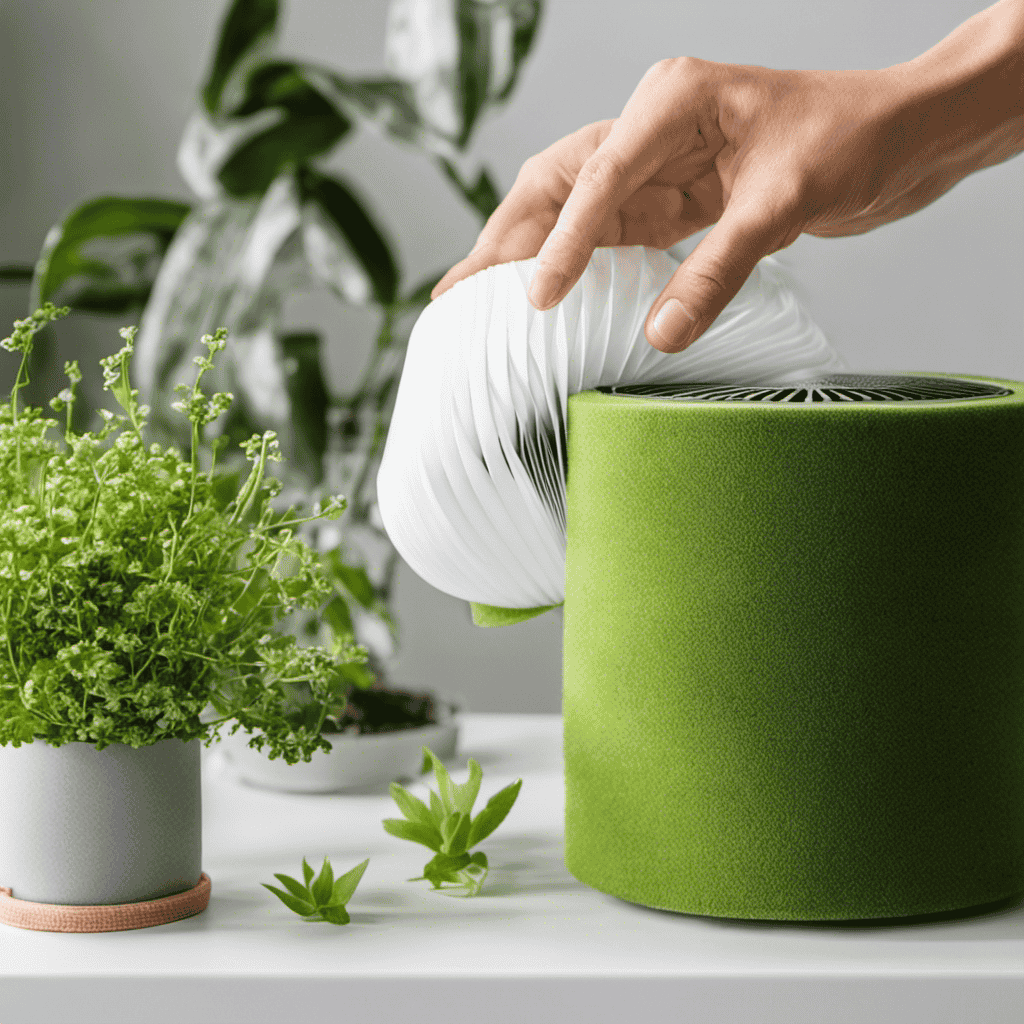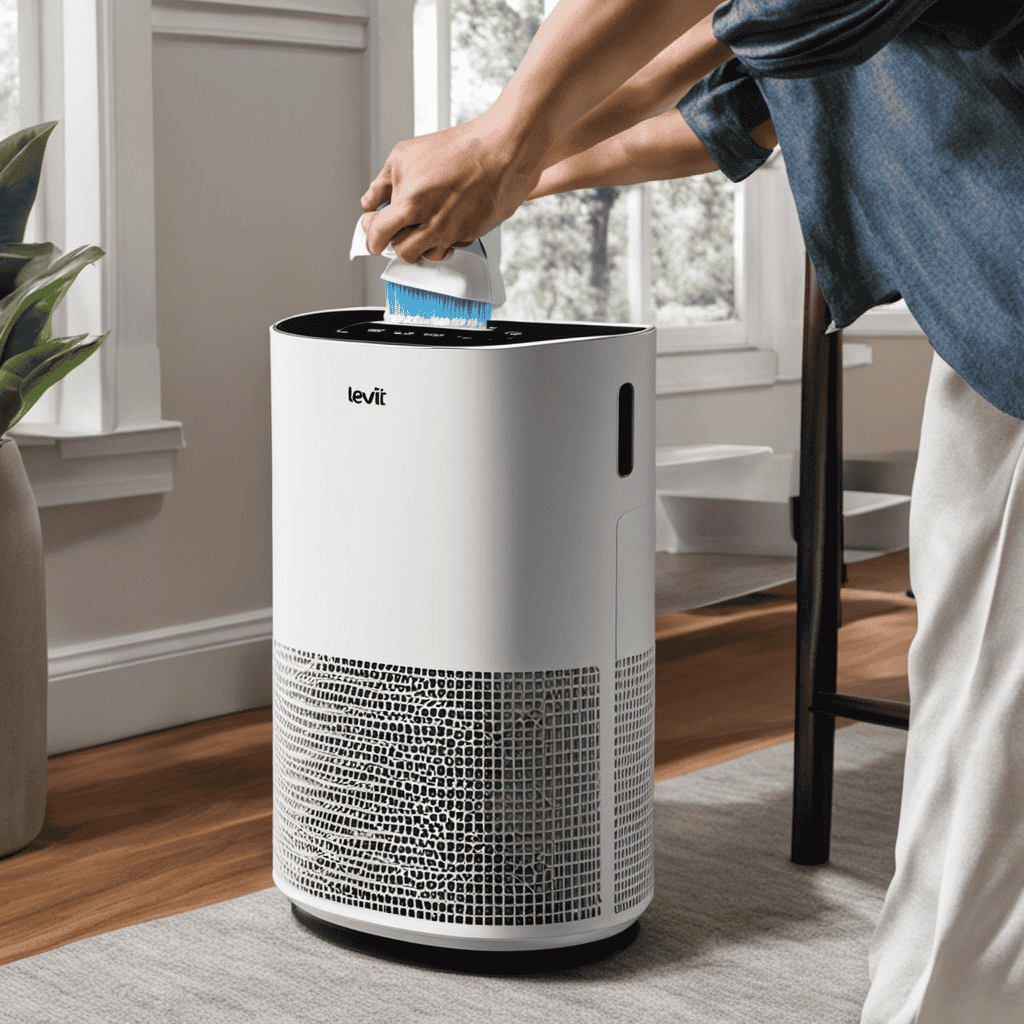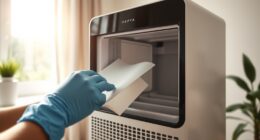I’m going to demonstrate the process of repurposing an air purifier filter, despite it appearing somewhat unconventional. Contrary to widespread opinion, recycling an air purifier filter is both an economical and eco-friendly choice.
In this article, I’ll guide you through the process of understanding different types of filters, signs of replacement, cleaning methods, and how to extend their lifespan.
With proper storage and maintenance, you can repurpose these filters for various purposes. Let’s explore the pros and cons of reusing air purifier filters while prioritizing safety.
Key Takeaways
- Reusable air purifier filters can be cleaned using methods such as vacuuming, washing with warm, soapy water, and using an air compressor.
- Proper maintenance and cleaning techniques can extend the lifespan of air purifier filters and ensure optimal performance.
- Reusing air purifier filters may save money in the short term, but it can lead to potential health risks and reduced filtration efficiency in the long run.
- Considering the pros and cons of reusing air purifier filters is important in making an informed decision, and proper handling, cleaning, and maintenance are crucial to maintain air quality.
Understanding Air Purifier Filters
To understand air purifier filters, you’ll need to know how they work and what different types are available.
Air purifier filters are an essential component of any air purifier system. They are designed to capture and remove airborne particles, such as dust, pollen, pet dander, and mold spores, from the air. These filters work by using a combination of physical and chemical processes to trap and neutralize contaminants.
DIY air purifier projects have gained popularity recently, as people look for cost-effective ways to improve indoor air quality. The benefits of air purifiers are numerous, including reducing allergies, improving respiratory health, and creating a cleaner and fresher living environment.
Understanding the different types of air purifier filters is crucial in selecting the right one for your needs.
Types of Air Purifier Filters
You can choose from various types of filters for your air purifier. When selecting a filter, it’s important to consider different sizes and filter materials to ensure optimal air purification.
Here are three types of filters commonly used:
-
HEPA (High Efficiency Particulate Air) Filters: These filters are made of densely packed fibers that can trap up to 99.97% of particles as small as 0.3 microns, including pollen, dust mites, and pet dander.
-
Activated Carbon Filters: These filters contain a porous material that can effectively absorb and remove odors, chemicals, and volatile organic compounds (VOCs) from the air.
-
Ionizer Filters: These filters use an electrical charge to generate negative ions, which attach to airborne pollutants, causing them to fall to the ground or stick to surfaces.
Signs That Your Air Purifier Filter Needs Replacing
When it’s time to replace your air purifier filter, there are a few signs to look out for. Regularly cleaning and replacing your air purifier filter is essential for maintaining clean and healthy indoor air quality. By doing so, you can effectively remove harmful pollutants and allergens from your home. Here are some signs that indicate it’s time to replace your air purifier filter:
| Signs | Ways to Clean Air Filters | Benefits of Replacing Air Filters Regularly |
|---|---|---|
| Reduced airflow | Vacuuming or washing | Improved air quality |
| Increased dust and debris in the air | Using a brush or compressed air | Reduced allergy symptoms |
| Unpleasant odors | Soaking in warm water and detergent | Longer lifespan of the air purifier |
Regularly cleaning and replacing your air purifier filter not only ensures optimal performance but also helps to maintain a healthier environment for you and your family.
Cleaning Methods for Reusable Air Purifier Filters
Regularly cleaning and replacing reusable filters is crucial for maintaining optimal performance and ensuring cleaner indoor air quality. DIY filter cleaning has several benefits, including cost savings and reduced environmental impact. Here are three effective methods for cleaning reusable air purifier filters:
-
Vacuuming: Using a handheld vacuum with a brush attachment, gently remove surface debris and dust from the filter. This method is quick and easy, but may not remove deeply embedded particles.
-
Washing: Submerge the filter in warm, soapy water and gently scrub with a soft brush. Rinse thoroughly and allow it to air dry completely before reinstalling. This method is more thorough and can remove dirt and allergens effectively.
-
Air Compressor: Using a low-pressure air compressor, blow air through the filter in the opposite direction of airflow. This method dislodges trapped particles and helps restore the filter’s efficiency.
Regular maintenance and cleaning of reusable filters not only prolongs their lifespan but also ensures that your air purifier continues to effectively remove pollutants from your indoor air.
How to Extend the Lifespan of Your Air Purifier Filter
To maximize the lifespan of your purifier’s filter, it’s important to follow proper maintenance and cleaning techniques. Regular filter maintenance offers a multitude of benefits that can improve the efficiency and effectiveness of your air purifier.
First, cleaning the filter regularly helps remove accumulated dust, allergens, and other particles, ensuring cleaner air in your home. Additionally, DIY air purifier hacks, such as vacuuming the filter or gently washing it with water, can further extend its lifespan.
DIY Air Purifier Filter Reconditioning Techniques
When it comes to extending the lifespan of your air purifier filter, DIY filter reconditioning techniques can be a game-changer. Not only do these methods help you save money, but they also have several benefits for the environment.
By reconditioning your air purifier filter, you can:
-
Remove accumulated dirt and debris: Using a vacuum or compressed air, you can effectively clean the filter and remove any trapped particles.
-
Restore airflow: Over time, filters can become clogged, reducing their effectiveness. Reconditioning helps restore airflow, ensuring optimal performance.
-
Prolong filter life: Regular maintenance and reconditioning can significantly extend the lifespan of your filter, reducing the frequency of replacements.
Proper Storage and Maintenance of Used Air Purifier Filters
When it comes to maintaining air purifier filters, understanding proper cleaning techniques is essential.
Not only can these techniques help to remove accumulated dirt and debris, but they can also extend the lifespan of the filters.
Filter Cleaning Techniques
Using a soft brush or vacuuming gently are effective techniques for cleaning an air purifier filter. Regular cleaning is essential to maintain the efficiency of the filter and ensure clean air in your home.
Here are some important factors to consider when cleaning your filter:
-
Cleaning frequency:
-
Regular cleaning is recommended, depending on the air quality and usage of the purifier.
-
A general rule of thumb is to clean the filter every 2-3 months, but it may vary in different environments.
-
Filter material selection:
-
Different filters require different cleaning methods.
-
HEPA filters, for example, are not washable and should be replaced when dirty.
-
Cleaning process:
-
Gently brush off or vacuum the surface of the filter to remove dust and debris.
-
Avoid using water or harsh chemicals as they can damage the filter material.
Extended Filter Lifespan
To extend the lifespan of your filter, it’s important to follow proper cleaning techniques and replace it when necessary. However, there are also benefits to reusing a filter, as it can help in extending filter efficiency.
When a filter is properly cleaned and maintained, it can continue to effectively trap and remove airborne particles for a longer period of time. By reusing a filter, you not only save money but also reduce waste by preventing unnecessary replacements.
It is important to note that reusing a filter should only be done if it is still in good condition and has not reached its maximum lifespan. Regular cleaning, such as vacuuming or washing, can help remove trapped particles and restore the filter’s efficiency. However, it is crucial to remember that filters do have a finite lifespan and should be replaced when they become damaged or no longer effective in maintaining air quality.
Reusing Air Purifier Filters for Different Purposes
If you want to reuse an air purifier filter for different purposes, you can try using it in a different room or for a different allergen. This DIY filter reconditioning technique can save you money and provide additional health benefits.
By repurposing the filter, you can effectively remove various allergens and pollutants from the air, ensuring a clean and healthy environment.
Here are three ways you can reuse your air purifier filter:
-
Use it in a different room: Move the filter to a different area of your home to target specific pollutants or allergens. For example, if you have a filter that is effective against pet dander, you can place it in a room where your pets spend a lot of time.
-
Target different allergens: Instead of using the filter for its original purpose, repurpose it to target different allergens. This allows you to address specific concerns, such as pollen or dust mites, effectively.
-
Combine with other filters: If you have multiple air purifiers, you can use the reused filter in conjunction with other filters to create a comprehensive filtration system. This can help trap a wider range of pollutants and improve indoor air quality.
Pros and Cons of Reusing Air Purifier Filters
When considering the pros and cons of reusing air purifier filters, there are several key points to consider.
Firstly, there are potential health risks associated with reusing filters. They can become contaminated with bacteria, mold, and other harmful particles over time.
Secondly, the cost-effectiveness of reusing filters should be evaluated. While it may save money in the short term, it could lead to increased health expenses in the long run.
Lastly, the impact on air quality is a crucial factor. Reusing filters that are not properly cleaned or maintained can result in reduced filtration efficiency and poorer indoor air quality.
Health Risks of Reusing
Reusing an air purifier filter can pose health risks if not properly cleaned and maintained. It is crucial to handle the filter with care and follow proper cleaning procedures to ensure a safe indoor environment.
Here are some health risks associated with reusing air purifier filters and the importance of proper handling:
-
Contamination: Reusing a dirty filter can lead to the accumulation of harmful pollutants, allergens, and bacteria, which can be released back into the air you breathe.
-
Reduced filtration efficiency: Over time, a reused filter may lose its effectiveness in capturing airborne particles, compromising the air quality in your space.
-
Mold growth: If not cleaned and dried thoroughly, a moist filter can become a breeding ground for mold and mildew, potentially causing respiratory issues.
To mitigate these risks, always follow the manufacturer’s instructions for cleaning and replacing the filter, ensuring proper hygiene and maintenance. Your health and well-being depend on it.
Cost-Effectiveness of Reusing
In the previous section, we discussed the potential health risks of reusing an air purifier filter. Now, let’s delve into the cost-effectiveness of reusing filters. By reusing filters, you can significantly reduce filter replacement costs, which can add up over time. The frequency at which you can reuse a filter depends on various factors such as the quality of the filter, the air quality in your environment, and your cleaning routine. To help you understand the potential savings, consider the following table:
| Frequency of Reuse | Filter Replacement Costs Saved |
|---|---|
| Every 2 months | $20 |
| Every 4 months | $40 |
| Every 6 months | $60 |
As you can see, reusing filters can lead to significant cost savings. However, it is important to note that the impact on air quality should also be considered. Let’s explore this further in the next section.
Impact on Air Quality
To maintain optimum air quality, it’s crucial to consider the impact of reusing a filter. Reusing an air purifier filter can have both positive and negative effects on air pollution reduction. Here are three sub-lists that illustrate the impact:
-
Improved filtration efficiency: Reusing a filter allows it to accumulate more pollutants over time, enhancing its ability to capture harmful particles in the air.
-
Decreased airflow: As a filter gets clogged with pollutants, it may restrict the airflow, reducing the effectiveness of the air purifier and potentially allowing more pollutants to escape.
-
Potential for contamination: Repeated use of a filter can lead to the accumulation of bacteria, mold, and other contaminants, which can be released back into the air, compromising the cleanliness and quality.
Understanding the impact of reusing air purifier filters is essential for making informed decisions about air pollution reduction. Now, let’s explore the safety precautions when reusing these filters.
Safety Precautions When Reusing Air Purifier Filters
Make sure you carefully follow safety precautions when reusing air purifier filters. While reusing filters can contribute to filter longevity and reduce the environmental impact, it is important to take certain steps to ensure your safety. Here are some guidelines to follow:
| Safety Precautions |
|---|
| Wear protective gloves and a mask when handling used filters |
| Clean the filter thoroughly before reuse |
| Inspect the filter for any damages or signs of wear |
| Follow the manufacturer’s instructions for proper filter maintenance |
Frequently Asked Questions
Can I Reuse an Air Purifier Filter Indefinitely?
Yes, it is possible to reuse an air purifier filter for an extended period. By following proper maintenance and cleaning techniques, the lifespan of the filter can be significantly extended, ensuring effective air purification.
Are All Air Purifier Filters Reusable?
Not all air purifier filters are reusable. Some can be washed, but not all. Reusing a filter may have benefits such as cost savings, but it’s important to follow manufacturer guidelines for proper maintenance.
Can I Use a Reused Air Purifier Filter in a Different Air Purifier Model?
No, using a reused air purifier filter in a different model may not be effective. Each air purifier model has specific requirements for filters, and using the wrong one can reduce the benefits of reusing air purifier filters.
How Often Should I Replace a Reusable Air Purifier Filter?
I replace my reusable air purifier filter every 6-12 months to ensure optimal performance. To extend its lifespan, I clean it regularly by gently vacuuming or rinsing with water.
Can I Use a Reused Air Purifier Filter for Medical Purposes?
Yes, you can reuse an air purifier filter for medical purposes. However, it is important to note that reusing air purifier filters for allergies or pet odors may not provide the same level of filtration as a new filter.
Conclusion
In conclusion, reusing air purifier filters can be a cost-effective and environmentally friendly option. By properly cleaning and maintaining the filters, their lifespan can be extended, reducing the need for frequent replacements.
However, it is important to note that not all filters are designed to be reusable, so it is crucial to check the manufacturer’s instructions before attempting to reuse them.
According to a study conducted by the Environmental Protection Agency, reusing air purifier filters can help reduce solid waste by up to 50%. This statistic highlights the potential impact of reusing filters in reducing our environmental footprint.










